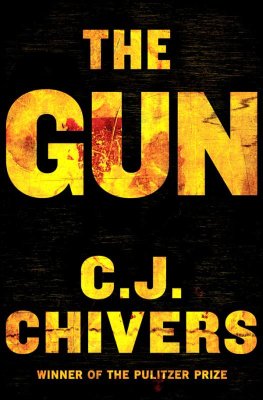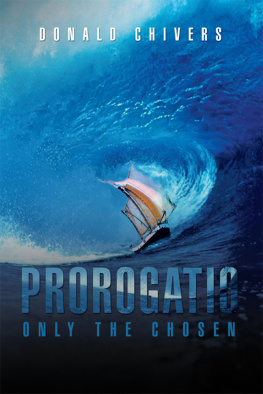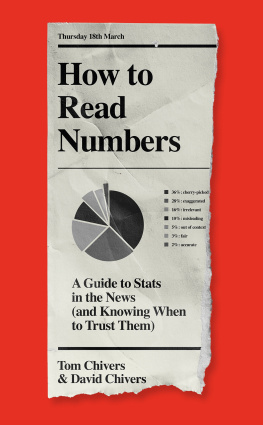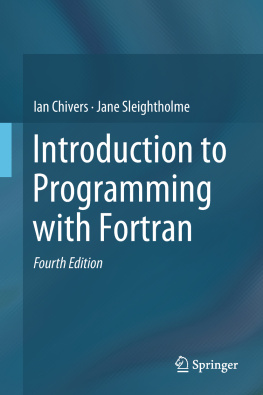Chivers - The Gun
Here you can read online Chivers - The Gun full text of the book (entire story) in english for free. Download pdf and epub, get meaning, cover and reviews about this ebook. year: 2010, publisher: Simon & Schuster, genre: Politics. Description of the work, (preface) as well as reviews are available. Best literature library LitArk.com created for fans of good reading and offers a wide selection of genres:
Romance novel
Science fiction
Adventure
Detective
Science
History
Home and family
Prose
Art
Politics
Computer
Non-fiction
Religion
Business
Children
Humor
Choose a favorite category and find really read worthwhile books. Enjoy immersion in the world of imagination, feel the emotions of the characters or learn something new for yourself, make an fascinating discovery.
The Gun: summary, description and annotation
We offer to read an annotation, description, summary or preface (depends on what the author of the book "The Gun" wrote himself). If you haven't found the necessary information about the book — write in the comments, we will try to find it.
Chivers: author's other books
Who wrote The Gun? Find out the surname, the name of the author of the book and a list of all author's works by series.
The Gun — read online for free the complete book (whole text) full work
Below is the text of the book, divided by pages. System saving the place of the last page read, allows you to conveniently read the book "The Gun" online for free, without having to search again every time where you left off. Put a bookmark, and you can go to the page where you finished reading at any time.
Font size:
Interval:
Bookmark:
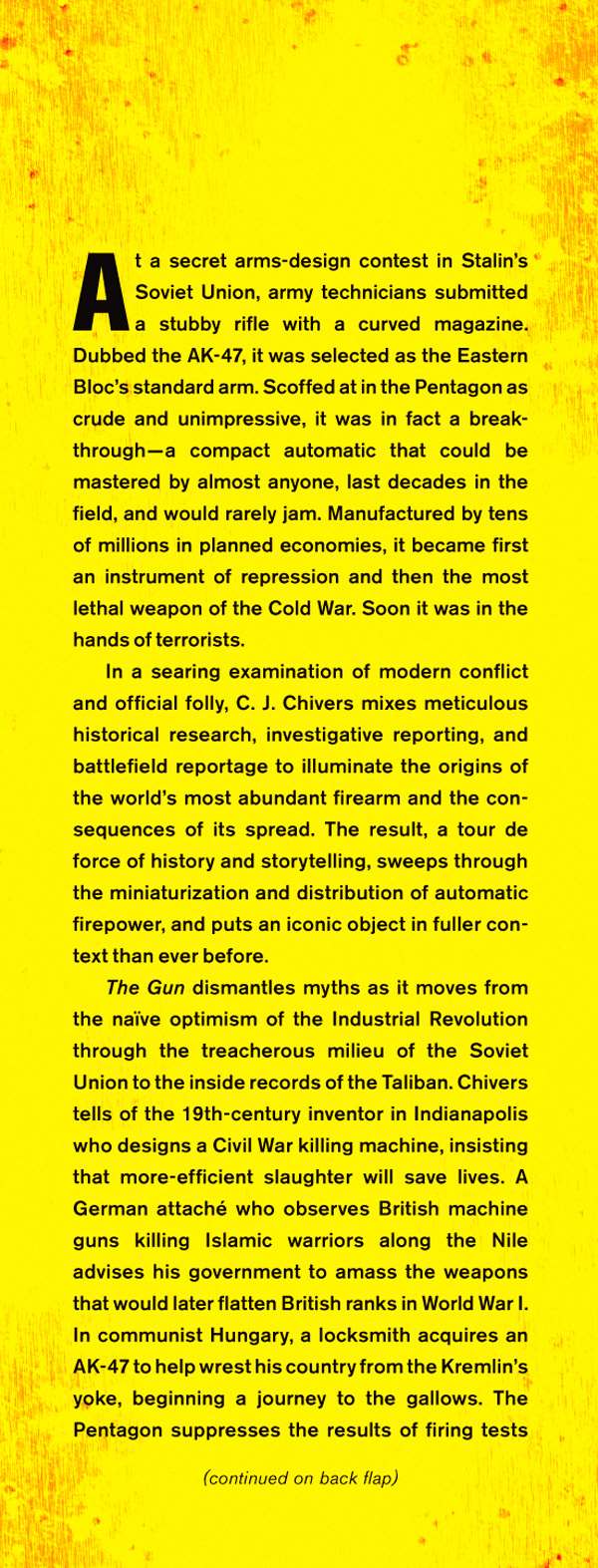



Simon & Schuster
1230 Avenue of the Americas
New York, NY 10020
www.SimonandSchuster.com
Copyright 2010 by C. J. Chivers
All rights reserved, including the right to reproduce this book or
portions thereof in any form whatsoever. For information address
Simon & Schuster Subsidiary Rights Department,
1230 Avenue of the Americas, New York, NY 10020
First Simon & Schuster hardcover edition October 2010
SIMON & SCHUSTER and colophon are registered trademarks
of Simon & Schuster, Inc.
For information about special discounts for bulk purchases,
please contact Simon & Schuster Special Sales at
1-866-506-1949 or business@simonandschuster.com.
The Simon & Schuster Speakers Bureau can bring authors
to your live event. For more information or to book an event,
contact the Simon & Schuster Speakers Bureau at
1-866-248-3049 or visit our website at www.simonspeakers.com.
Designed by Kyoko Watanabe
Manufactured in the United States of America
10 9 8 7 6 5 4 3 2 1
Library of Congress Cataloging-in-Publication Data
Chivers, C. J.
The gun / C. J. Chivers
1st Simon & Schuster hardcover ed.
p. cm.
Includes bibliographical references.
1. AK-47 rifleHistory. 2. WarHistory. 3. Machine guns
Technological innovationsHistory. 4. FirearmsTechnological
innovationsHistory. I. Title.
UD395.A16C47 2010
623.4'424dc22 2010020459
ISBN 978-0-7432-7076-2
ISBN 978-1-4391-9653-3 (ebook)
For Natalya K. Estemirova
Bezstrashnaya Natasha
Fearless Natasha
The Investigator
Murdered for her work in Chechnya
An Example for All
February 28, 1958July 15, 2009
Inventors seldom benefit themselves. They benefit the people.
Richard J. Gatling, inventor of the Gatling gun
THE GUN
Stalins Tools of War
Outside an Institute Known by a Codeword, Nadezhda, on the Steppe in the Kazakh Soviet Socialist Republic
The atomic bomb rested on a tower one hundred feet above the ground. Known as RDS-1, it was shaped like a huge metal teardrop with rivets and bolts along its sides. Everything had been prepared. Inside its shell was a uranium and plutonium charge equal to about twenty kilotons of TNT, making it a rough equivalent to the weapon the United States had used to destroy Nagasaki four years before. In the hours after midnight the scientists had departed, and now, shortly before dawn on August 29, 1949, they gathered at their instruments in a control bunker more than six miles away, where they were watched by Lavrenty Beria, chief of Stalins secret police. Detonation was set for 6:00 A.M. The Soviet Union was moments from entering the atomic ageending the American monopoly in atomic arms, securing the Kremlins status atop a global superpower, and giving the Cold War its sense of doomsday menace. This was a decade after the purges, two decades after the brutalities of collectivization, and in a postwar period in which German prisoners of war were used as forced labor and captured Soviet soldiers returned from German camps had been interrogated, incarcerated, and, sometimes, put to death. Berias methods of pursuing Stalins will were well-known. The lead physicist, Igor V. Kurchatov, and his team were anxious. If the bomb did not work, some of these scientists expected to be shot.
The test range, on an arid basin northwest of Semipalatinsk, a frontier city where Russians had been sent to exile since czarist times, was a methodically assembled period piece. Soviet soldiers and laborers had built All of this work had been cloaked in the strictest secrecy that Beria could organize. Kurchatovs research center, roughly an hours bouncing drive away over a dirt road, was on no maps. It had its own postal code, which often changed. One code name was Nadezhda, the Russian word for hope.
And now it was time.
There was an enormous white flash, then an extended bright glow. A sky-splitting roar and blast rushed outward, blowing asunder buildings, twisting the bridge, buckling bunkers as it blew through. In the first instant the soil near the tower had been liquefied, becoming a molten syrup that shot through the air, coating flat surfaces and the ground in a searing, radioactive caramel. As the wave whooshed through the nearest sectors, tank barrels and artillery pieces bent like reeds. Farther out, animals were roasted; then farther, they were singed. Farther still, they were bombarded with radiation that would erupt into burns that would kill them later, as the scientists documented their declines. The blast wave took a half minute to sweep over the steppe to the command bunker, which shuddered. When the rumbling subsided, Beria, Kurchatov, and his team stepped outside and looked at a steep-sided mushroom cloud, sucking up Timber and dust spun high overhead. Success.
Inside Factory No. 74 of the Izhevsk Machine, Engineering, and Motor Plant Complex, in the Russian Soviet Federated Socialist Republic
As diplomatic cables about the atomic explosion moved from embassies in Moscow to Western capitals, about eleven hundred miles to the west of the test site, in a Russian industrial city in the Ural range, another of Stalins secret military projects was gaining momentum. Within the dark brick walls of a set of immense factories, a product was being prepared for mass production. Teams of engineers, armorers, and factory supervisors were fine-tuning its design. Communist Party leaders insisted that these factories were engaged in the manufacture of automobiles. But this product was neither a vehicle nor any of its parts. It was a weapon: a strange-looking rifle, deviating from the classic forms.
At a glance, the new rifle was in many ways peculiar, an oddity, a reason to furrow brows and shake heads. Its components were simple, inelegant, and by Western standards, of seemingly workmanlike craftsmanship. The impression it created was the puzzling embodiment of a firearm compromise, a blend of design choices no existing Western army was willing yet to make. It was midsized in important measuresshorter than the infantry rifles it would displace but longer than the submachine guns that had been in service for thirty years. It fired a medium-powered cartridge, not powerful enough for long-range sniping duty, but with adequate energy to strike lethally and cause terrible wounds within the ranges at which almost all combat occurs. The weapon was not merely a middleweight. It was a breakthrough arm. It could be fired automatically, and at a rate like those of the machine guns that already had changed the way wars were fought. It could be fired on single fire, like a rifle of yore. None of the Soviet Unions Cold War opponents had managed to conceive of, much less produce, a firearm of such firepower at such compact size. And this new weapon had other useful traits. It had little recoil compared to most rifles of its time. It was so reliable, even when soaked in bog water and coated with sand, that its Soviet testers had trouble making it jam. And its design was a testament to simplicity, so much so that its basic operation might be grasped within minutes, and Soviet teachers would soon learn that it could be disassembled and reassembled by Slavic schoolboys in less than thirty seconds flat. Together these traits meant that once this weapon was distributed, the small-statured, the mechanically disinclined, the dimwitted, and the untrained might be able to wield, with little difficulty or instruction, a lightweight automatic rifle that could push out blistering fire for the lengths of two or three football fields. For the purpose for which it was designedas a device that allowed ordinary men to kill other men without extensive training or undue complicationsthis was an eminently well-conceived tool.
Font size:
Interval:
Bookmark:
Similar books «The Gun»
Look at similar books to The Gun. We have selected literature similar in name and meaning in the hope of providing readers with more options to find new, interesting, not yet read works.
Discussion, reviews of the book The Gun and just readers' own opinions. Leave your comments, write what you think about the work, its meaning or the main characters. Specify what exactly you liked and what you didn't like, and why you think so.




